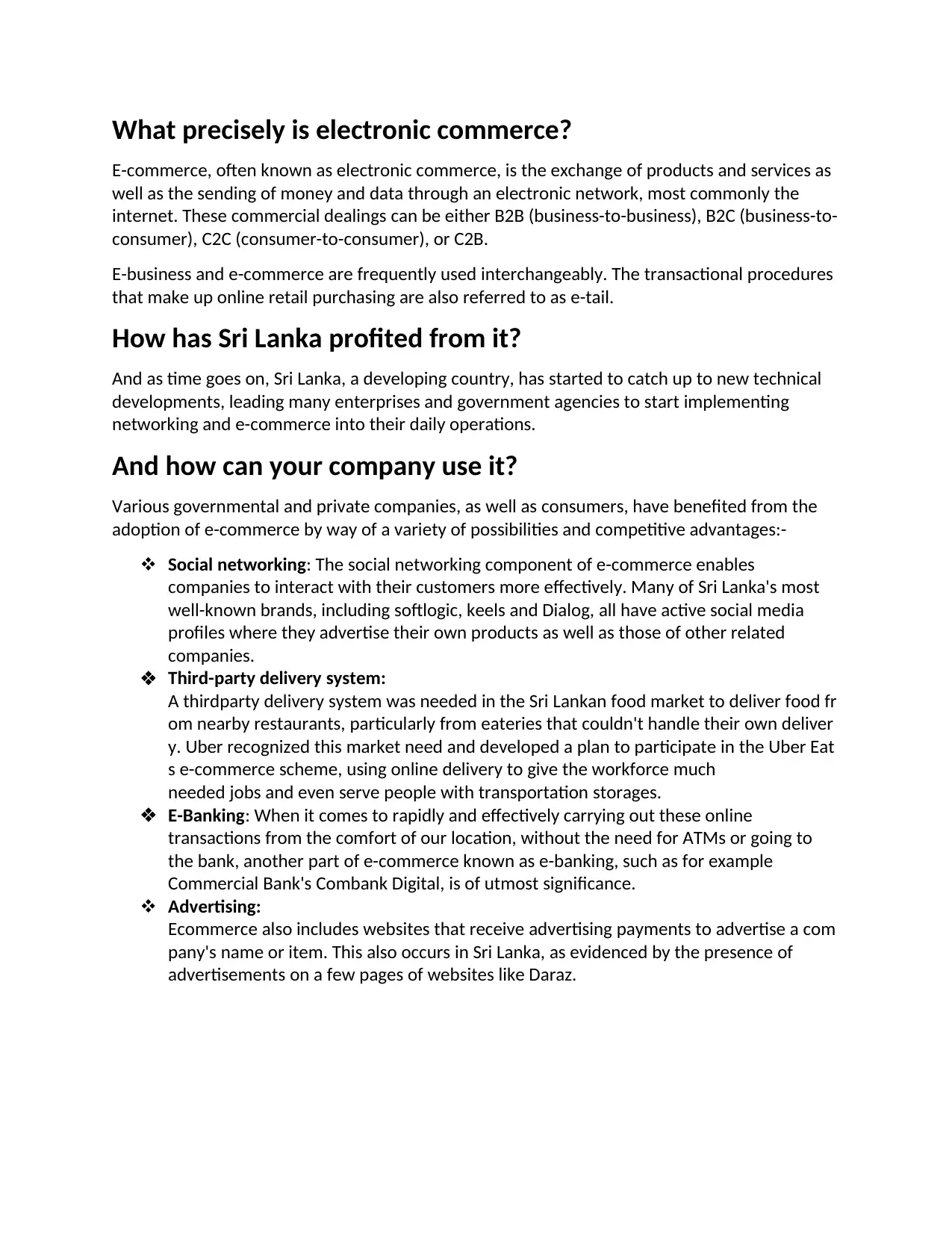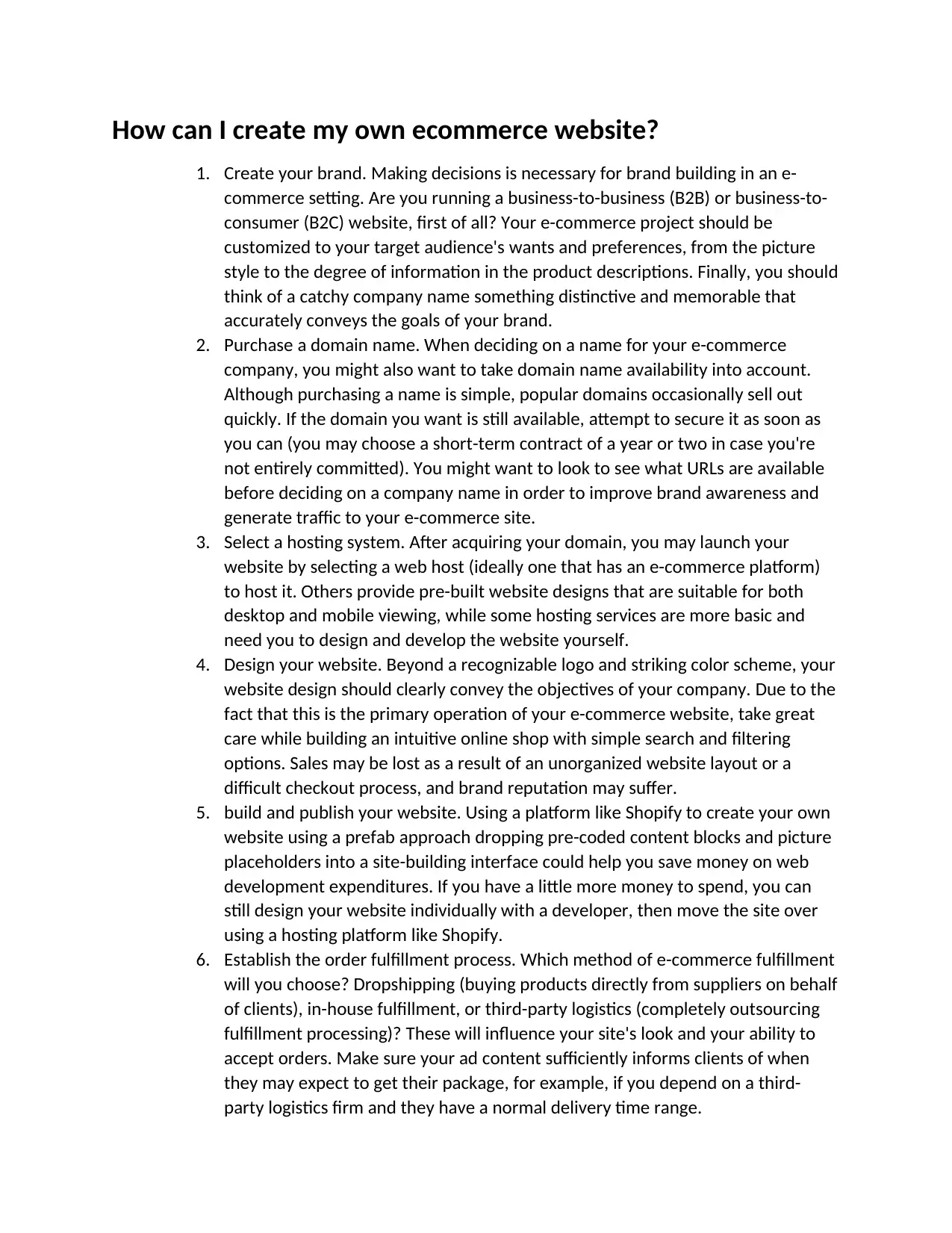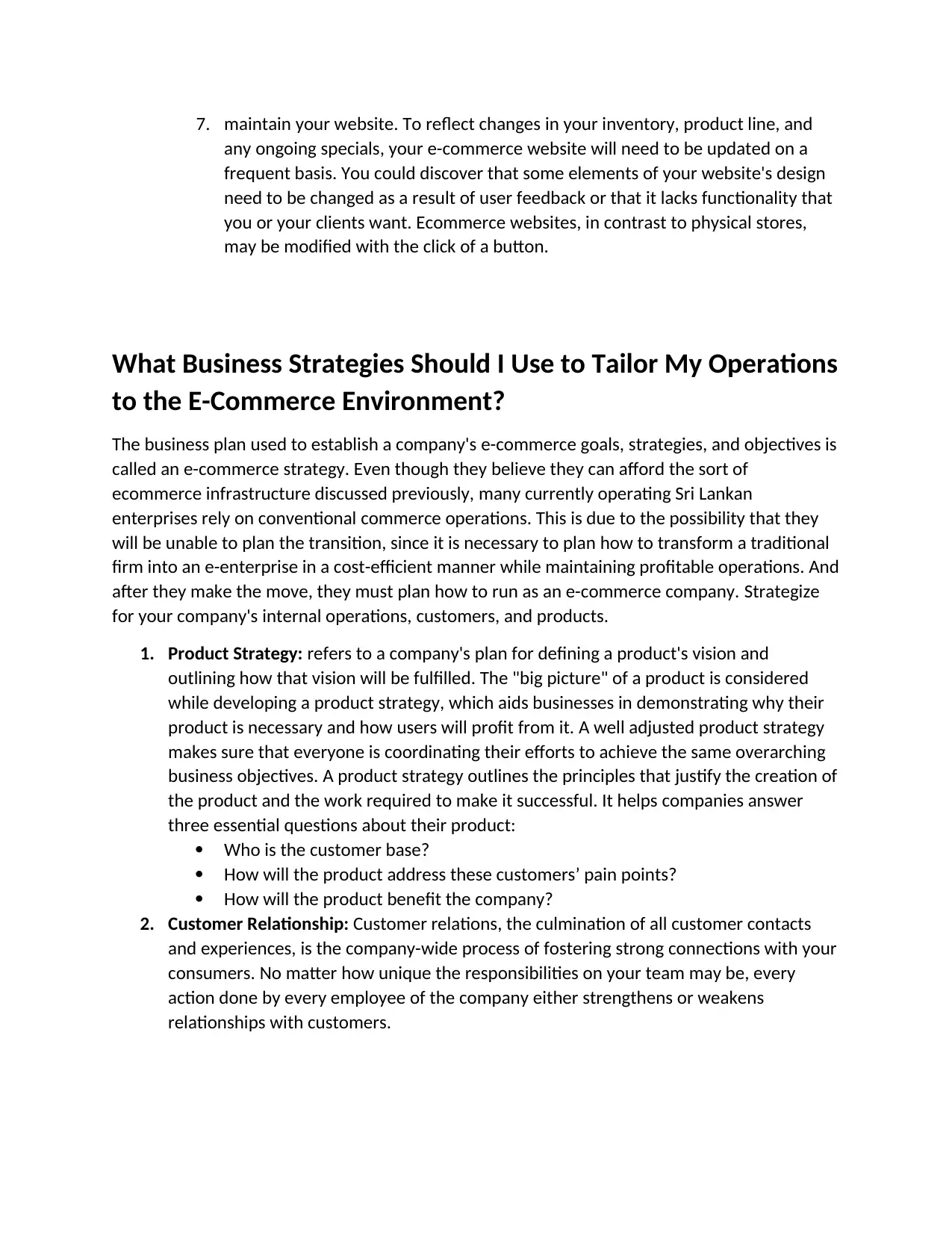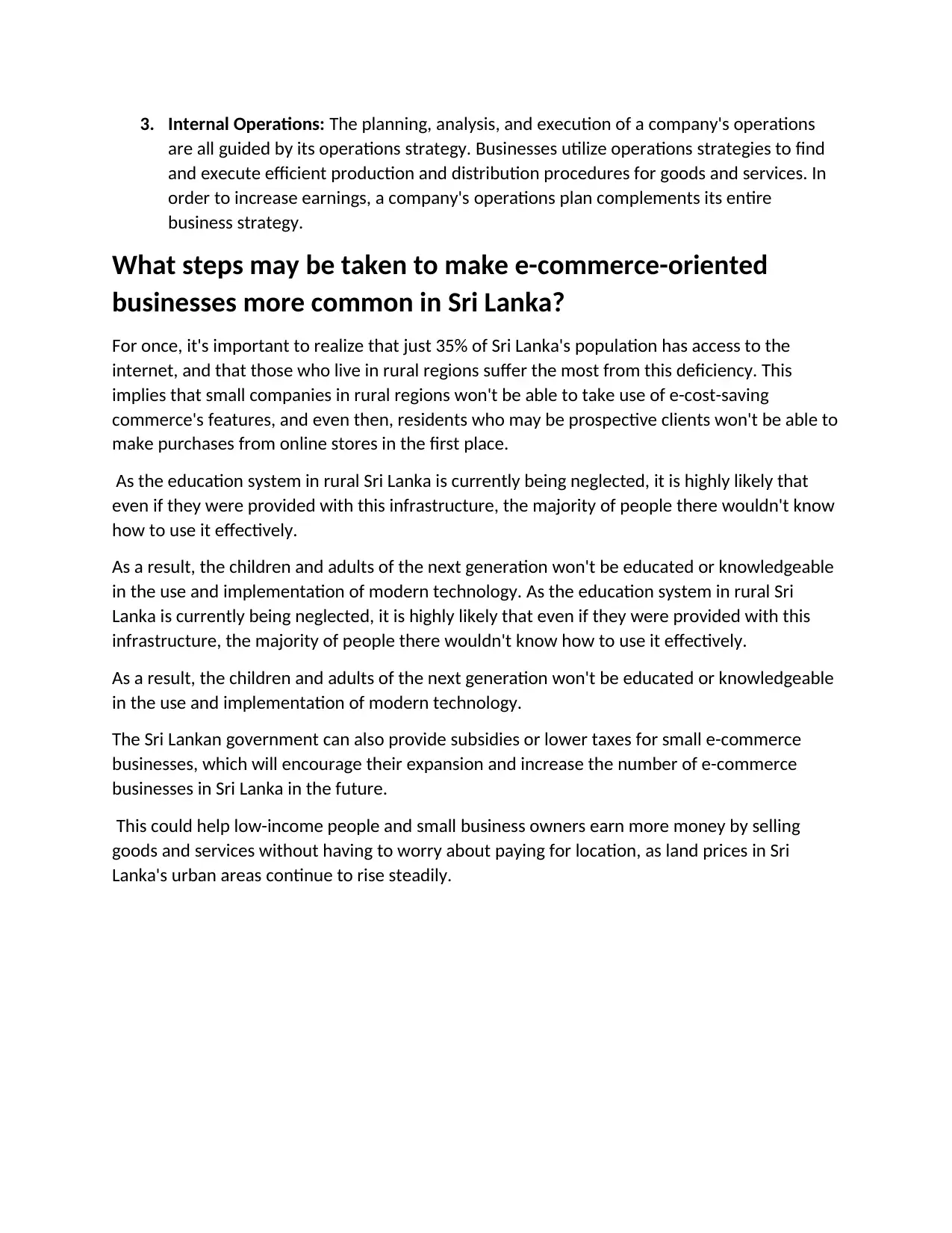E-commerce in Sri Lanka: Strategies, Benefits, and Future Growth
VerifiedAdded on 2023/01/05
|5
|1715
|92
Report
AI Summary
This report provides a comprehensive overview of e-commerce, focusing on its significance and development within Sri Lanka. It begins by defining e-commerce and its various models (B2B, B2C, C2C, C2B), then delves into how Sri Lanka has benefited from its adoption, highlighting the role of social networking, third-party delivery systems, e-banking, and advertising. The report further explains the process of creating an e-commerce website, including branding, domain name selection, hosting, website design, and order fulfillment. It then outlines crucial business strategies tailored for the e-commerce environment, such as product strategy, customer relationship management, and internal operations. The report concludes by addressing the challenges and steps needed to promote the growth of e-commerce in Sri Lanka, emphasizing the importance of internet access, education, and government support through subsidies or tax incentives. It references sources like the World Bank and local news to support its analysis.

What precisely is electronic commerce?
E-commerce, often known as electronic commerce, is the exchange of products and services as
well as the sending of money and data through an electronic network, most commonly the
internet. These commercial dealings can be either B2B (business-to-business), B2C (business-to-
consumer), C2C (consumer-to-consumer), or C2B.
E-business and e-commerce are frequently used interchangeably. The transactional procedures
that make up online retail purchasing are also referred to as e-tail.
How has Sri Lanka profited from it?
And as time goes on, Sri Lanka, a developing country, has started to catch up to new technical
developments, leading many enterprises and government agencies to start implementing
networking and e-commerce into their daily operations.
And how can your company use it?
Various governmental and private companies, as well as consumers, have benefited from the
adoption of e-commerce by way of a variety of possibilities and competitive advantages:-
Social networking: The social networking component of e-commerce enables
companies to interact with their customers more effectively. Many of Sri Lanka's most
well-known brands, including softlogic, keels and Dialog, all have active social media
profiles where they advertise their own products as well as those of other related
companies.
Third-party delivery system:
A thirdparty delivery system was needed in the Sri Lankan food market to deliver food fr
om nearby restaurants, particularly from eateries that couldn't handle their own deliver
y. Uber recognized this market need and developed a plan to participate in the Uber Eat
s e-commerce scheme, using online delivery to give the workforce much
needed jobs and even serve people with transportation storages.
E-Banking: When it comes to rapidly and effectively carrying out these online
transactions from the comfort of our location, without the need for ATMs or going to
the bank, another part of e-commerce known as e-banking, such as for example
Commercial Bank's Combank Digital, is of utmost significance.
Advertising:
Ecommerce also includes websites that receive advertising payments to advertise a com
pany's name or item. This also occurs in Sri Lanka, as evidenced by the presence of
advertisements on a few pages of websites like Daraz.
E-commerce, often known as electronic commerce, is the exchange of products and services as
well as the sending of money and data through an electronic network, most commonly the
internet. These commercial dealings can be either B2B (business-to-business), B2C (business-to-
consumer), C2C (consumer-to-consumer), or C2B.
E-business and e-commerce are frequently used interchangeably. The transactional procedures
that make up online retail purchasing are also referred to as e-tail.
How has Sri Lanka profited from it?
And as time goes on, Sri Lanka, a developing country, has started to catch up to new technical
developments, leading many enterprises and government agencies to start implementing
networking and e-commerce into their daily operations.
And how can your company use it?
Various governmental and private companies, as well as consumers, have benefited from the
adoption of e-commerce by way of a variety of possibilities and competitive advantages:-
Social networking: The social networking component of e-commerce enables
companies to interact with their customers more effectively. Many of Sri Lanka's most
well-known brands, including softlogic, keels and Dialog, all have active social media
profiles where they advertise their own products as well as those of other related
companies.
Third-party delivery system:
A thirdparty delivery system was needed in the Sri Lankan food market to deliver food fr
om nearby restaurants, particularly from eateries that couldn't handle their own deliver
y. Uber recognized this market need and developed a plan to participate in the Uber Eat
s e-commerce scheme, using online delivery to give the workforce much
needed jobs and even serve people with transportation storages.
E-Banking: When it comes to rapidly and effectively carrying out these online
transactions from the comfort of our location, without the need for ATMs or going to
the bank, another part of e-commerce known as e-banking, such as for example
Commercial Bank's Combank Digital, is of utmost significance.
Advertising:
Ecommerce also includes websites that receive advertising payments to advertise a com
pany's name or item. This also occurs in Sri Lanka, as evidenced by the presence of
advertisements on a few pages of websites like Daraz.
Paraphrase This Document
Need a fresh take? Get an instant paraphrase of this document with our AI Paraphraser

How can I create my own ecommerce website?
1. Create your brand. Making decisions is necessary for brand building in an e-
commerce setting. Are you running a business-to-business (B2B) or business-to-
consumer (B2C) website, first of all? Your e-commerce project should be
customized to your target audience's wants and preferences, from the picture
style to the degree of information in the product descriptions. Finally, you should
think of a catchy company name something distinctive and memorable that
accurately conveys the goals of your brand.
2. Purchase a domain name. When deciding on a name for your e-commerce
company, you might also want to take domain name availability into account.
Although purchasing a name is simple, popular domains occasionally sell out
quickly. If the domain you want is still available, attempt to secure it as soon as
you can (you may choose a short-term contract of a year or two in case you're
not entirely committed). You might want to look to see what URLs are available
before deciding on a company name in order to improve brand awareness and
generate traffic to your e-commerce site.
3. Select a hosting system. After acquiring your domain, you may launch your
website by selecting a web host (ideally one that has an e-commerce platform)
to host it. Others provide pre-built website designs that are suitable for both
desktop and mobile viewing, while some hosting services are more basic and
need you to design and develop the website yourself.
4. Design your website. Beyond a recognizable logo and striking color scheme, your
website design should clearly convey the objectives of your company. Due to the
fact that this is the primary operation of your e-commerce website, take great
care while building an intuitive online shop with simple search and filtering
options. Sales may be lost as a result of an unorganized website layout or a
difficult checkout process, and brand reputation may suffer.
5. build and publish your website. Using a platform like Shopify to create your own
website using a prefab approach dropping pre-coded content blocks and picture
placeholders into a site-building interface could help you save money on web
development expenditures. If you have a little more money to spend, you can
still design your website individually with a developer, then move the site over
using a hosting platform like Shopify.
6. Establish the order fulfillment process. Which method of e-commerce fulfillment
will you choose? Dropshipping (buying products directly from suppliers on behalf
of clients), in-house fulfillment, or third-party logistics (completely outsourcing
fulfillment processing)? These will influence your site's look and your ability to
accept orders. Make sure your ad content sufficiently informs clients of when
they may expect to get their package, for example, if you depend on a third-
party logistics firm and they have a normal delivery time range.
1. Create your brand. Making decisions is necessary for brand building in an e-
commerce setting. Are you running a business-to-business (B2B) or business-to-
consumer (B2C) website, first of all? Your e-commerce project should be
customized to your target audience's wants and preferences, from the picture
style to the degree of information in the product descriptions. Finally, you should
think of a catchy company name something distinctive and memorable that
accurately conveys the goals of your brand.
2. Purchase a domain name. When deciding on a name for your e-commerce
company, you might also want to take domain name availability into account.
Although purchasing a name is simple, popular domains occasionally sell out
quickly. If the domain you want is still available, attempt to secure it as soon as
you can (you may choose a short-term contract of a year or two in case you're
not entirely committed). You might want to look to see what URLs are available
before deciding on a company name in order to improve brand awareness and
generate traffic to your e-commerce site.
3. Select a hosting system. After acquiring your domain, you may launch your
website by selecting a web host (ideally one that has an e-commerce platform)
to host it. Others provide pre-built website designs that are suitable for both
desktop and mobile viewing, while some hosting services are more basic and
need you to design and develop the website yourself.
4. Design your website. Beyond a recognizable logo and striking color scheme, your
website design should clearly convey the objectives of your company. Due to the
fact that this is the primary operation of your e-commerce website, take great
care while building an intuitive online shop with simple search and filtering
options. Sales may be lost as a result of an unorganized website layout or a
difficult checkout process, and brand reputation may suffer.
5. build and publish your website. Using a platform like Shopify to create your own
website using a prefab approach dropping pre-coded content blocks and picture
placeholders into a site-building interface could help you save money on web
development expenditures. If you have a little more money to spend, you can
still design your website individually with a developer, then move the site over
using a hosting platform like Shopify.
6. Establish the order fulfillment process. Which method of e-commerce fulfillment
will you choose? Dropshipping (buying products directly from suppliers on behalf
of clients), in-house fulfillment, or third-party logistics (completely outsourcing
fulfillment processing)? These will influence your site's look and your ability to
accept orders. Make sure your ad content sufficiently informs clients of when
they may expect to get their package, for example, if you depend on a third-
party logistics firm and they have a normal delivery time range.

7. maintain your website. To reflect changes in your inventory, product line, and
any ongoing specials, your e-commerce website will need to be updated on a
frequent basis. You could discover that some elements of your website's design
need to be changed as a result of user feedback or that it lacks functionality that
you or your clients want. Ecommerce websites, in contrast to physical stores,
may be modified with the click of a button.
What Business Strategies Should I Use to Tailor My Operations
to the E-Commerce Environment?
The business plan used to establish a company's e-commerce goals, strategies, and objectives is
called an e-commerce strategy. Even though they believe they can afford the sort of
ecommerce infrastructure discussed previously, many currently operating Sri Lankan
enterprises rely on conventional commerce operations. This is due to the possibility that they
will be unable to plan the transition, since it is necessary to plan how to transform a traditional
firm into an e-enterprise in a cost-efficient manner while maintaining profitable operations. And
after they make the move, they must plan how to run as an e-commerce company. Strategize
for your company's internal operations, customers, and products.
1. Product Strategy: refers to a company's plan for defining a product's vision and
outlining how that vision will be fulfilled. The "big picture" of a product is considered
while developing a product strategy, which aids businesses in demonstrating why their
product is necessary and how users will profit from it. A well adjusted product strategy
makes sure that everyone is coordinating their efforts to achieve the same overarching
business objectives. A product strategy outlines the principles that justify the creation of
the product and the work required to make it successful. It helps companies answer
three essential questions about their product:
Who is the customer base?
How will the product address these customers’ pain points?
How will the product benefit the company?
2. Customer Relationship: Customer relations, the culmination of all customer contacts
and experiences, is the company-wide process of fostering strong connections with your
consumers. No matter how unique the responsibilities on your team may be, every
action done by every employee of the company either strengthens or weakens
relationships with customers.
any ongoing specials, your e-commerce website will need to be updated on a
frequent basis. You could discover that some elements of your website's design
need to be changed as a result of user feedback or that it lacks functionality that
you or your clients want. Ecommerce websites, in contrast to physical stores,
may be modified with the click of a button.
What Business Strategies Should I Use to Tailor My Operations
to the E-Commerce Environment?
The business plan used to establish a company's e-commerce goals, strategies, and objectives is
called an e-commerce strategy. Even though they believe they can afford the sort of
ecommerce infrastructure discussed previously, many currently operating Sri Lankan
enterprises rely on conventional commerce operations. This is due to the possibility that they
will be unable to plan the transition, since it is necessary to plan how to transform a traditional
firm into an e-enterprise in a cost-efficient manner while maintaining profitable operations. And
after they make the move, they must plan how to run as an e-commerce company. Strategize
for your company's internal operations, customers, and products.
1. Product Strategy: refers to a company's plan for defining a product's vision and
outlining how that vision will be fulfilled. The "big picture" of a product is considered
while developing a product strategy, which aids businesses in demonstrating why their
product is necessary and how users will profit from it. A well adjusted product strategy
makes sure that everyone is coordinating their efforts to achieve the same overarching
business objectives. A product strategy outlines the principles that justify the creation of
the product and the work required to make it successful. It helps companies answer
three essential questions about their product:
Who is the customer base?
How will the product address these customers’ pain points?
How will the product benefit the company?
2. Customer Relationship: Customer relations, the culmination of all customer contacts
and experiences, is the company-wide process of fostering strong connections with your
consumers. No matter how unique the responsibilities on your team may be, every
action done by every employee of the company either strengthens or weakens
relationships with customers.
⊘ This is a preview!⊘
Do you want full access?
Subscribe today to unlock all pages.

Trusted by 1+ million students worldwide

3. Internal Operations: The planning, analysis, and execution of a company's operations
are all guided by its operations strategy. Businesses utilize operations strategies to find
and execute efficient production and distribution procedures for goods and services. In
order to increase earnings, a company's operations plan complements its entire
business strategy.
What steps may be taken to make e-commerce-oriented
businesses more common in Sri Lanka?
For once, it's important to realize that just 35% of Sri Lanka's population has access to the
internet, and that those who live in rural regions suffer the most from this deficiency. This
implies that small companies in rural regions won't be able to take use of e-cost-saving
commerce's features, and even then, residents who may be prospective clients won't be able to
make purchases from online stores in the first place.
As the education system in rural Sri Lanka is currently being neglected, it is highly likely that
even if they were provided with this infrastructure, the majority of people there wouldn't know
how to use it effectively.
As a result, the children and adults of the next generation won't be educated or knowledgeable
in the use and implementation of modern technology. As the education system in rural Sri
Lanka is currently being neglected, it is highly likely that even if they were provided with this
infrastructure, the majority of people there wouldn't know how to use it effectively.
As a result, the children and adults of the next generation won't be educated or knowledgeable
in the use and implementation of modern technology.
The Sri Lankan government can also provide subsidies or lower taxes for small e-commerce
businesses, which will encourage their expansion and increase the number of e-commerce
businesses in Sri Lanka in the future.
This could help low-income people and small business owners earn more money by selling
goods and services without having to worry about paying for location, as land prices in Sri
Lanka's urban areas continue to rise steadily.
are all guided by its operations strategy. Businesses utilize operations strategies to find
and execute efficient production and distribution procedures for goods and services. In
order to increase earnings, a company's operations plan complements its entire
business strategy.
What steps may be taken to make e-commerce-oriented
businesses more common in Sri Lanka?
For once, it's important to realize that just 35% of Sri Lanka's population has access to the
internet, and that those who live in rural regions suffer the most from this deficiency. This
implies that small companies in rural regions won't be able to take use of e-cost-saving
commerce's features, and even then, residents who may be prospective clients won't be able to
make purchases from online stores in the first place.
As the education system in rural Sri Lanka is currently being neglected, it is highly likely that
even if they were provided with this infrastructure, the majority of people there wouldn't know
how to use it effectively.
As a result, the children and adults of the next generation won't be educated or knowledgeable
in the use and implementation of modern technology. As the education system in rural Sri
Lanka is currently being neglected, it is highly likely that even if they were provided with this
infrastructure, the majority of people there wouldn't know how to use it effectively.
As a result, the children and adults of the next generation won't be educated or knowledgeable
in the use and implementation of modern technology.
The Sri Lankan government can also provide subsidies or lower taxes for small e-commerce
businesses, which will encourage their expansion and increase the number of e-commerce
businesses in Sri Lanka in the future.
This could help low-income people and small business owners earn more money by selling
goods and services without having to worry about paying for location, as land prices in Sri
Lanka's urban areas continue to rise steadily.
Paraphrase This Document
Need a fresh take? Get an instant paraphrase of this document with our AI Paraphraser

Referred to :
1. https://data.worldbank.org/indicator/IT.NET.USER.ZS?locations=LK&most_recent_value_desc=false
2. http://inford.org/why-are-rural-educational-systems-seriously-neglected-in-sri-lanka/
3. - https://www.dailynews.lk/2022/09/15/business/287234/land-prices-western-province-increase-
14
4. https://www.themorning.lk/how-divided-are-we-digitally/
1. https://data.worldbank.org/indicator/IT.NET.USER.ZS?locations=LK&most_recent_value_desc=false
2. http://inford.org/why-are-rural-educational-systems-seriously-neglected-in-sri-lanka/
3. - https://www.dailynews.lk/2022/09/15/business/287234/land-prices-western-province-increase-
14
4. https://www.themorning.lk/how-divided-are-we-digitally/
1 out of 5
Related Documents
Your All-in-One AI-Powered Toolkit for Academic Success.
+13062052269
info@desklib.com
Available 24*7 on WhatsApp / Email
![[object Object]](/_next/static/media/star-bottom.7253800d.svg)
Unlock your academic potential
Copyright © 2020–2025 A2Z Services. All Rights Reserved. Developed and managed by ZUCOL.





